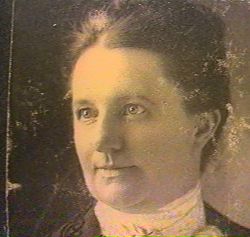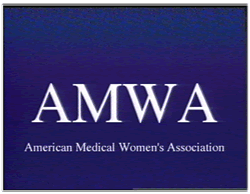Promotional Video

This short promotional video is designed to attract female medical students to learn more about--and become involved in--the activities of the 80-year-old American Medical Women's Association, an organization that, according to its vision statement, is focused on "empowering women to lead in improving health for all, within a model that reflects the unique perspective of women."

View video clip (6:30 minutes)
RealVideo (3.9MB; streaming)
[Requires Real Player G2, available free at www.real.com]
Quicktime (5.6MB; streaming)
[Requires Quicktime 4.0, available free at www.apple.com/quicktime/]
For many years, I'd wanted to share some of the stories about my great-grandmother, Dr. Emma Linton Hill, one of the first women doctors in this country. When I had the opportunity to create a video for a graduate school class in health care promotion, I knew I wanted somehow to make use of the photos, letters, speeches and journals that are a part of my family history.Of course, what I really wanted to do was a feature-length documentary--but in order to create a manageable project that I could complete in four weeks, I decided to produce a short promotional video for an organization that my great-grandmother helped to found: the American Medical Women's Association.
I was able to play at being Ken Burns and experiment with ways to try to bring old photos to life; I used my great-grandmother's original words wherever possible in the script and recruited my wonderful neighbor, Val Gyrisco, to read them. My doctor, who turned out to be an AMWA supporter, was persuaded to go in front of the camera and sing the organization's praises and another friend's young daughter, a second-year medical student involved in AMWA projects, also agreed to an on-camera interview.
The video runs a little over six minutes and has been shown at several student film and video screenings and on local cable television.
AMWA Script
[Logo of the American Medical Women's Association, with vision statement [MUSIC UNDER] AMWA: Empowering women to lead in improving health for all FADE TO SERIES OF QUICK CUTS UNDER VOICE-OVER NARRATION] 1) town overview of main street with horses and buggies 2) train depot sign showing "Oswego"
3) interior of doctor's office with skull in foreground, books in back
4) Emma and John sitting in office
5) close up of Emma Linton Hill (TWICE)
VO: (1) A hundred years ago, back when women doctors made up a small minority of the profession, Dr. Emma Linton Hill (5) began practicing medicine in a small town (2) in Kansas. She set up an office (3) with her husband John, (4) who'd earned his degree a few years earlier. (5) Getting her medical education in the 1890s hadn't been easy:
[PHOTO OF EMMA LINTON HILL IN OPERATING THEATER IN CHICAGO ; zoom in slowly past sea of male faces to her, seated in front, as actor quotes her tale; zoom out again so ends on full image] DR. HILL: "Not all professors welcomed the girls to their lectures on medical subjects...some had gatekeepers to prohibit women from attending. We must remember, in those bygone days women found scant welcome anywhere outside the bedroom and the kitchen." VO: On the first day she was to observe an operation, as she later recounted the tale to other female medical students,
DR. HILL: "As we awaited the arrival of the surgeon I was pelted with paper wads until I had to pull my hat down over my eyes for protection..But the surgeon, who saw what was happening, gave me the best seat to see his work. And I attended his next clinic day as if nothing had happened."
[CLOSEUP ON STATIONERY showing "Offices of Drs. Hill, Physicians and Surgeons" and image of happy baby] VO: Because she'd lost three of her own four pregnancies, she was personally interested in how doctors might provide more information about pre-natal health care--as well as raising a healthy, happy, child. As a daughter of a Quaker family that had a tradition of educating its women, she felt she could contribute by becoming a doctor herself. [1)full frame: PHOTO OF HORSE AND BUGGY 2) full frame: WINTER SCENE OF HOUSE/OFFICE
3) zoom on: SNOW TREES]
VO: (1)In the beginning years, she drove her own horse and buggy all over Labette County. HILL: (2) "There is much to enjoy on a long night ride alone. Going forth on a (3) winter night, with the moon on the pure white snow, I have encountered scenes of unequaled beauty."
[EMMA, SMILING, WITH MODEL-T] VO: But, as she would later warn a class of medical students: HILL: "You are expected to always be at your best--at the most inopportune times! In the middle of the night when the rain pours or the snow and sleet are peppering the road...You must snatch your medical case and your instrument case...you must cheerfully sally forth."
[PHOTO OF SMALLPOX VICTIM] VO: She saw patients with tuberculosis and typhoid, syphilis and smallpox. [MOTHER CRADLING CHILD WITH GROWTH] VO: Mothers who puzzled--or grieved--over their children's sicknesses. And she saw deaths that could have been prevented through education [AMA LETTERHEAD SHOWING HER NAME AS PUBLIC HEALTH CHAIR FOR STATE] VO: Believing in the special role women physicians could play in educating the public, she took an active role in American Medical Association. [CLOSEUP ON TEXT MOVING ALONG HANDWRITTEN SENTENCE, ""In 1909..."] In 1909 she helped launch the first organized movement in history for the general prevention of disease through specific education of the public about its causes and early care. [PHOTO OF EMMA IN LIBRARY] VO: Early diagnosis of diseases like TB and cancer dramatically changed treatment options. Understanding more about common colds could prevent pneumonia; better information about diet could prevent gastritis and many other problems. [CLOSE-UP on odd family shot, w/mirror?] HILL "Who can see more clearly the benefit that would come from this education...than the women physician? Who has felt its need more keenly?" [PORTRAIT OF EMMA WITH CHILD] HILL: "The day a woman brings into this world her child she gives a hostage to her god that she make this world a better place for that child to inhabit.." [GROUP SHOT OF AMWA WOMEN: zoom out from closeup on Hill to large group photo of AMWA women in 1937, banner with name prominent [LINGER on sign]
VO: Early outreach efforts included a series of public health lectures, a traveling exhibit on TB and a visiting nurse program for expectant mothers. At the forefront of these efforts were the women physicians of the AMA. In 1915, these women joined forces to form an aligned group that they named the Medical Women's National Association, to bring medical women together to address their shared concerns. [1) CLOSEUP IN AMWA PIN; dissolve to (2) MEDICAL WOMEN'S JOURNAL COVER}
VO: (1) Out of the efforts of doctors like Emma Linton Hill (2) and many others, the organization grew into the American Medical Women's Association--AMWA. With some 13,000 members today, AMWA continues to serve as a voice for empowering women in medicine. [HEAD SHOT of Dr. Joyce Leslie speaking, ID name and affiliation on-screen] LESLIE: "I think AMWA has done much to educate the medical community about the special contributions and special needs of women." [AMWA logo; dissolves quickly to next shot]
VO: And today, nearly 48 percent of AMWA's membership is medical students. [HEAD SHOT of Rebecca Hoover, second-year med student; ID name and affiliation on-screen]
HOOVER: "I decided I wanted to be a doctor because...."I got involved in AMWA my first year as a med student, doing..." [STILL W/WORDS] leadership
advocacy
education
expertise
mentoring
strategic alliances.
VO: AMWA--Dedicated to meeting challenges specific to women physicians in addition to addressing needs particular to women patients. [STILL WITH LIST OF CURRENT EDUCATION PROJECTS, INCLUDING coronary heart disease in women research breast and cervical cancer screening project for primary care physicians tobacco control project for women and girls child care program development VO: Many AMWA projects are designed to educate its physician members, the medical community, or the public. Our efforts depend on the contributions of our members--from pioneering women doctors like Emma Linton Hill to future MD Rebecca Hoover--to you. We need YOUR efforts, commitment, and input
[SPLIT SCREEN: Closeup/merging faces of Emma from oil portrait, face of Rebecca] VO: By the end of the next decade, nearly 30 percent of all practicing doctors will be women--and close to 50 percent of medical students. As a woman in medicine you'll be confronting many special issues. AMWA can help--and you can help AMWA. Find out out more about your local chapter activities. [AMWA LOGO] [MUSIC UP AND UNDER} VO: AMWA--The organization that empowers women to lead in improving health for all.
| HOME | TLC PRODUCTIONS | RESUME | CONTACT | SITE MAP |
| MULTIMEDIA | SOUND | IMAGES | WORDS | TRAVELOGUE |
©TLC Productions 1999. All rights reserved.
Unauthorized use or reposting of photos or graphics prohibited.

